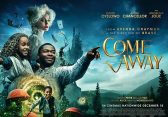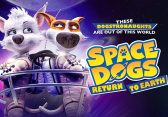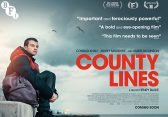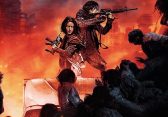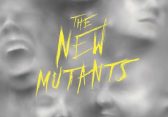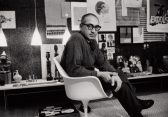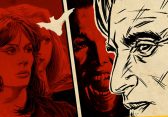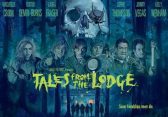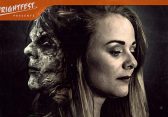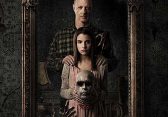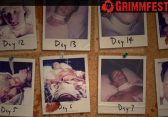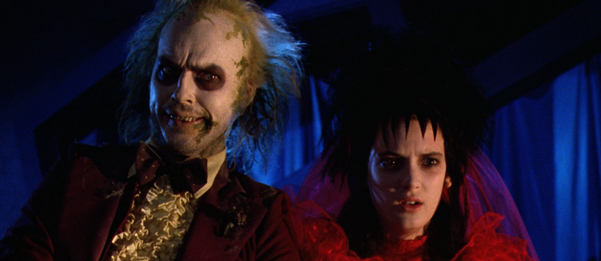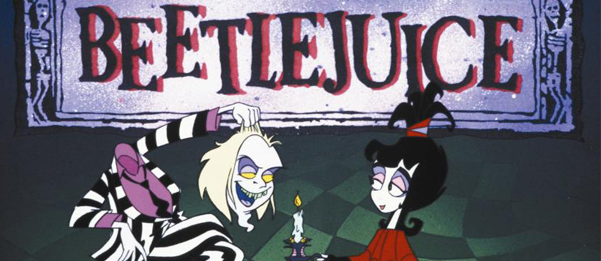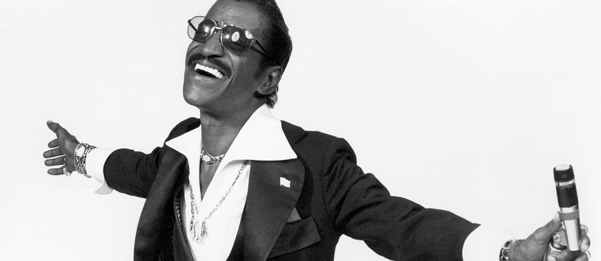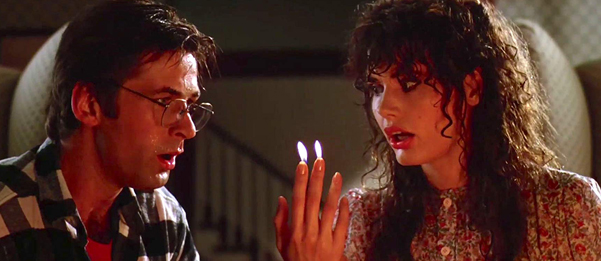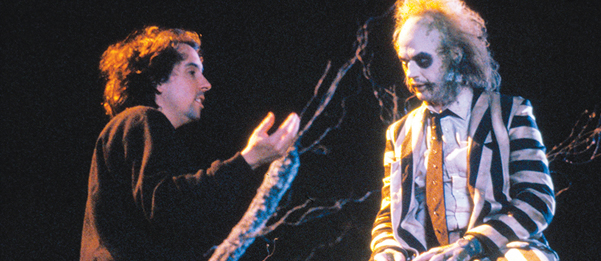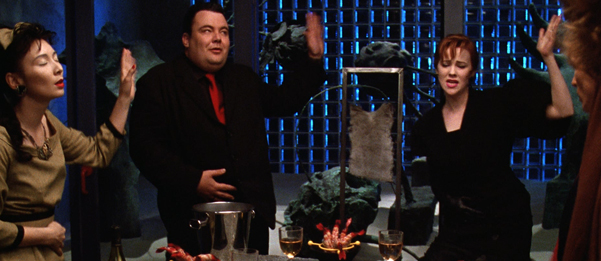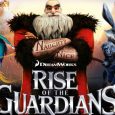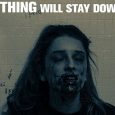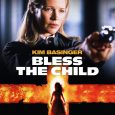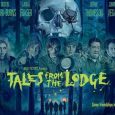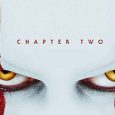Beetlejuice
19 August 1988 (UK release) 31st October 2018 (UK 4K Theatrical Remaster)
A recently-deceased husband and wife commission a bizarre demon to drive an obnoxious family out of their home.
Tim Burton
Michael Keaton, Alec Baldwin, Geena Davis, Winona Ryder
92 mins
What better time to revisit Beetlejuice than on it’s 30th Anniversary. The film has recently been given the 4K remaster treatment and been playing in cinemas around the country, making this the perfect opportunity to dig it up, blow off the cobwebs, and reevaluate its place in cinema.
Beetlejuice first screened for the public in the USA on 30th March 1988. Distributed by Warner Bros and made on a mid-budget of $15million, the film opened in approximately 1000 theatres and practically made it’s money back within its first week. After being a resounding success in America, the film opening in the UK on the 19th August of the same year and eventually grossed over $70million, making it the 10th highest grossing movie of that year. Thanks to the creative vision of young filmmaker Tim Burton (Frankenweenie, Alice In Wonderland) and confident marketing from the studio on what was ultimately a risky project, Beetlejuice was a success with critics and audiences alike.
Many critics praised Beetlejuice‘s bizarre but perfectly realized world and applauded the visual humor. It garnered a handful of perfect scores, with Mike Clark of USA Today writing: “So original that it’ll be years before a major filmmaker attempts another one. We’re talking black-belt cult-movie status here.” However, not everyone was convinced. Famed critic Roger Ebert called it “anticlimactic” and a minority of others thought the characters were weak, with the film’s reliance on visual tricks over story not producing a meritable product. But whatever the critics thought, it certainly found its audience and launched Tim Burton’s career into the mainstream.
The film spawned an animated TV series which ran for four series, as well as a number of video games and a theme park attraction at Universal’s various resorts, further proving it’s success. A large amount of merchandise was also created and is still being produced to this day. Despite being the second feature film from Burton, Beetlejuice was the first to fully embrace the Gothic style Burton is now famous for. His love of German expressionism and frequent use of bold stripes is birthed here. In fact, a few designs in Beetlejuice can later be seen in other Burton projects. A strong likeness to the sandworms appear in The Nightmare Before Christmas, and similar iconography can be found in Edward Scissorhands and Sleepy Hollow.
Tim Burton had previously achieved success with a variety of short films before directing the wacky comedy Pee Wee’s Big Adventure starring Paul Reubens. However, it was Beetlejuice that proved Burton was a bankable director with a vision. Only after the success of Beetlejuice was Burton’s production of Batman given the green light, which made him a household name and one of the hottest directors in Hollywood during the 1980s. This further success gave Burton free range to direct anything he wished, resulting in modern classics like Ed Wood and Edward Scissorhands.
But before that monumental success, Burton was stuck in a slow and arduous development on Batman. So in the meantime, he began reading scripts for his potential direction, but none struck a chord with his wild imagination. Not until studio executive, David Geffen of the Geffen Film Company sent Beetlejuice his way. Written by author Michael McDowell (who had previously worked with Burton on the TV show Alfred Hitchcock Presents), the script certainly interested young Tim. But due to creative differences, McDowell eventually left the project as new writers were brought on board.
Sammy Davis Jr. of the Rat Pack fame was the initial choice to play Beetlegeuse before Geffen suggested Michael Keaton (Spiderman: Homecoming, Birdman) due to his comedic experience. Initially, the film was much darker in tone and more akin to a horror flick. Beetlegeuse was to be depicted as a winged demon determined to murder the Deetzes rather than scare them, and his intention to marry Lydia replaced a motivation of rape. But a re-write by Warren Skaaren shifted the tone drastically and added the afterlife bureaucracy segments, making it much more like the film we know today.
Michael Keaton would eventually be cast as the title character, who was now toned down from a murderous demon to a troublesome ghostly pervert. He based his performance on Chop Top from The Texas Chainsaw Massacre 2, which is noticeable once pointed out, and Keaton has repeatedly expressed the role to be his favourite. The amount of fun he’s having on screen is plain to see, and ultimately Keaton’s expertise at improvising makes it very difficult to imagine anyone else in the role.
Alec Baldwin (Mission: Impossible – Fallout, Rock Of Ages) and Geena Davis (Thelma & Louise, The Fly) play Adam and Barbara, the couple recently deceased who find themselves being haunted by the living invading their old home. Bill Pullman was once considered for the role of Adam before Baldwin got the part – a casting decision that maybe Baldwin wished came true as it’s reported that he disliked the film greatly and was very unhappy with his performance. I feel that he’s being a little too hard on himself as the part doesn’t offer much depth, but he’s certainly likeable as a cookie cutter, “white picket fence” American. Geena Davis was the first actor to sign on for the film, with others being much harder to convince because “they didn’t know what to think of the weird script.” An underrated actress, it’s always nice to watch Geena Davis in films, and her role in Beetlejuice is no exception. It may not be a complex role, but she brings some much-needed warmth to the picture and is the driving force behind the couples eventual adoption of Lydia.
Fresh-faced Winona Ryder (Bram Stoker’s Dracula, Edward Scissorhands) rounds off the main cast as Lydia, the unappreciated and misunderstood member of the Deetzes. This only being her third film, Ryder demonstrates her charisma admirably. But like the rest of the cast, their characters are simple and overshadowed by Beetlegeuse’s insane antics. The remaining members of the family are a cartoonish bunch consisting of the much-loved character actors Catherine O’Hara and (the now less loved) Jeffrey Jones. The late Glenn Shadix also plays their interior designer Otho and supplies a memorable performance.
With the title being Beetlejuice (which Warner Bros thought was unmarketable and wanted the safer title House Ghosts) you’d expect the titular character to feature heavily. But almost like the shark in Jaws, it’s surprising to find Beetlegeuse absent through long sections of the picture. There are some character teases early on which makes for a wonderful build-up. But even when unleashed, Keaton’s bio-exorcist only ends up appearing in 17-and-a-half minutes of the film. This will undoubtedly disappoint some who are viewing it for the first time, and I personally would have liked to of seen more of Beetlegeuse instead of the Deetzes. But it is certainly true that leaving the audience wanting more, instead of less, is for the best. Beetlegeuse’s brief appearances consequently make a large impact as Keaton is absolutely electric on screen, so it could be argued that increasing his screen time could dilute the character in some way.
The films special effects were headed by Peter Kuran, Alan Munro, Robert Short, and Ted Rae, and are one of the films most defining features. But for a movie with such a focus on visual effects, the team was only given a small amount of $1 million to craft all of the miniatures, puppets, and prosthetic effects, as well as using stop-motion animation and blue screen. According to Burton, who grew up on cheap sci-fi and horror B movies, it was never his intention to make anything realistic, stating “I wanted to make them look cheap and purposely fake-looking”. With this in mind, the wide arrange of effects employed in Beetlejuice is incredibly impressive. It’s unequivocally Burton, but you can never really predict what might be coming next. It avoids simply being weird for weird’s sake and achieves a bizarre style of its own, creating some striking imagery that will imprint itself onto your brain.
Longtime collaborator Danny Elfman composed the score for Beetlejuice and is one of the finest examples of the two working together. Elfman is the king of maniacal whimsy and this is him at his most gleeful and devilish. From its opening credit sequence that is totally elevated by a bombastic theme to quieter moments around the home, the score works as it knows when to be front and centre, and when to support in the background. It’s motifs also make it enjoyable listening outside of the film and is worthy of purchase. However, the score is on the short side, totalling just 36 minutes, and outside of Elfman’s usual style, there isn’t much variety to be found. The soundtrack is also accompanied by two now-legendary songs performed by Harry Belafonte. “Day-O” features in the now-famous scene in which the Deetzes are supernaturally compelled to dance and mime along with the American reggae song. The song itself is as much associated with the film as Elfman’s score and actually re-charted in several countries due to the film’s popularity. The second song “Jump in Line” appears at the very end of the film, and nicely plays out into the credits.
It’s difficult to comment on Beetlejuice‘s lasting legacy. It’s a film made with passion and love, and can confidently be called a success as an oddball bit of 80s cinema. But if like me, you saw many of Burton’s other films before his second feature, it’s impossible to feel the same delight and surprise that audiences felt back in the late 80s, before Tim Burton became… Tim Burton. It’s even possible that some might be disappointed due to the hype and praise surrounding the film nowadays. This is a director still finding his feet, and so things like character substance and pacing have yet to be perfected. Nonetheless, its importance in the career of Tim Burton shouldn’t be underestimated. Without Beetlejuice, Warner Bros may never have had the confidence to green light 1989s Batman, and surely would not have given him so much creative freedom with it. ‘The Ghost With the Most’ demonstrated that audiences were on board with Burton’s wacky Gothic style, which is still going strong with his latest release, 2016’s Miss Peregrine’s Home for Peculiar Children.
Despite its actual success, Beetlejuice is oddly considered a cult film today. Perhaps this is due to it’s ever increasing fanbase because of the current 1980s nostalgia craze. But thankfully it mostly deserves the high regard its garnered, being exceedingly charming, unique, and well made. But I would warn newcomers to keep their expectations somewhat sensible, as it might not be the film they quite expect. I would also argue that whilst this isn’t Burton’s best work, it was the project that defined him as an artist and is thus the most important part of his filmography.

